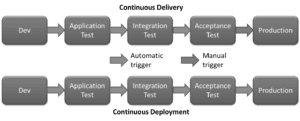Introduction:
If you are a software developer, you may be wondering what the difference between Continuous Integration and the new method of continuous delivery is. In short, Continuous Delivery and Integration should be complementary, not mutually exclusive. In reality, the two approaches are not equivalent. Continuous Integration is the basis for continuous delivery, while Continuous Delivery is the process of deploying new Software. So, here are some of the most important differences between the two approaches. Read on to learn more about them.
Continually Deliver the Code:
Continuous Integration focuses on frequent feature releases with minimum bugs. Continuous Delivery collects code from a shared repository and continuously delivers it to production environments. When used in conjunction with each other, Continuous Delivery increases software quality and ensures a bug-free environment. This article will discuss the main benefits of CI and CD in more detail. We’ve compiled some of the most common features, and discussed how to make them work for your company.
Use Automated Build Processes:
The goal of continuous integration and delivery is to have frequent communication among the development team. Everyone should know what changes have been made, and when. If a build fails to pass, a developer should report it immediately to the stakeholder. Fortunately, this is fairly easy to achieve with monitoring tools. These tools help developers keep track of the status of their builds and alert developers to errors. Hence, the benefits of CI and CD can’t be ignored.
Agile Software Development:
Continuous Integration and Continuous Delivery are two different concepts, yet they complement each other. Combined, they provide maximum output. Both concepts share similar benefits and features. In the case of Continuous Integration and Continuous Delivery, automated tests ensure that bugs are caught early and are not able to reach the production phase. Combined, these two methods result in better-quality software. You should consider both, but the primary differences are significant.
Automated Testing and Building:
Continuous Integration is the process of automating build and testing. The developers share their changes in a shared version-control repository. After every small update, an automated build or test runs. This prevents release-day hell and keeps developers from spending countless hours on the last hours resolving bugs. If you are developing software with continuous integration and Continuous Delivery, you won’t need a tester unless your team has implemented automated testing.

Continually Delivering
Continuous delivery ensures the sustainable release of changes. Continuous Integration ensures the stability of an application by automating the release process. It automatically deploys every change that has passed through the production pipeline, without any human intervention. Only failed tests will prevent the deployment of changes. These two processes are complementary and should be used together.
Continually releasing code is a crucial step in DevOps and Agile practices. The continuous delivery approach is the pinnacle of end-to-end automated software development. By incorporating continuous integration and deployment into your workflow, your development team can stay on top of business demands and meet their customers’ needs. Continually delivering code makes the entire process smoother for everyone. If you haven’t heard of Continuous Delivery, start your journey today! With this course, you will gain knowledge and experience in using some of the latest DevOps tools, such as Jenkins and Docker.
Continually Delivering Software is another way to increase efficiency. But continuous Integration requires developers to integrate new code into a shared repository, which allows for automated testing and build processes. Automation is a key component of continuous delivery, which guarantees the timely and reliable delivery of changes. This also provides a consistent pipeline for software development, increasing business agility. And when it is time to deploy the software, a continuous delivery procedure is used.
CI/CD software pipelines are especially useful for high-risk environments where physical access makes it difficult to identify and remediate problems. This method allows developers to deploy small, incremental changes with high confidence, without worrying about affecting production environments. The EdgeEngine CLI is integrated into GitLab CI/CD. The GitLab Docs have examples and a tutorial for setting up EdgeEngine and using it in CI/CD.

